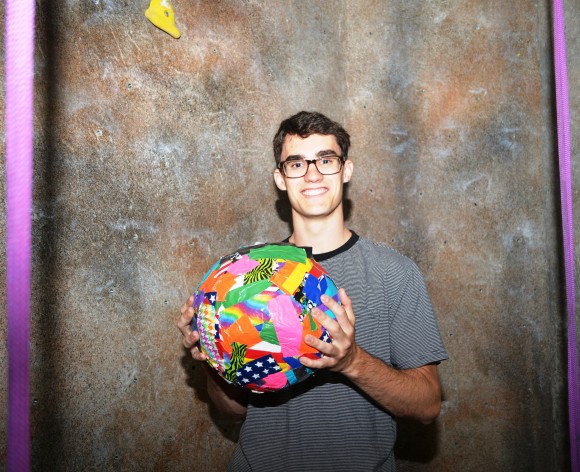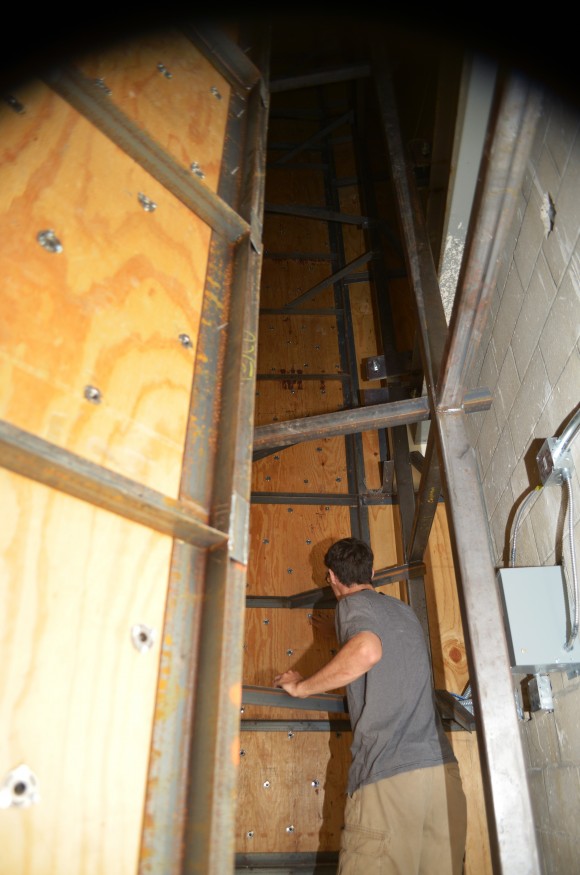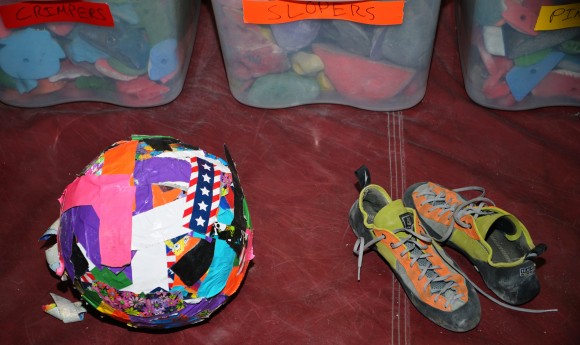Somewhere in this story is going to be a joke about a square peg and a round hole.
By the time finals week rolls around, the activity slows, the students go home and things get real quiet in a dark corner of the basement of the Sandhu Residence Hall — and then it all comes apart.
Pieces of the Doti-Struppa Rock Wall detritus begin to litter the landing pad at the bottom of the 51-foot wall.
The climbing wall gets it’s annual makeover.
Each hold on the wall is removed in a time-intensive process where the rock-wall team goes up with a hand tool and a bucket. Then each hold is unscrewed, put in the bucket and eventually sorted for size.
All the tape pieces used to mark routes up the wall are collected and added to a large, wildly colored ball.

Carsen Kelliher ’15 holds the massive ball of route-marking tape that has accumulated over the years.
After sorting, the holds are cleaned with an acid bath to remove the accumulated dust, chalk and microscopic bits of shed human skin cells.
“Yeah, that can be a little gross. I’ve seen other (rock walls) use a pressure cleaner, but we need to get these clean,” said Carsen Kelliher ’15, a rock-wall staff member. Really clean.
And then comes the arduous process of putting each hold back into the wall. Kelliher tried to count the number of holds based on each foot of the wall. He figures there are 2,000.
Every single socket in the wall has to be inspected — front and back. The dark side of the wall is a dusty crevasse unto its own. Little natural light gets in.
Actually, it’s nearly pitch black in there, minus the flash of a camera. Cell phone screens make it look worse because of cast shadows.
Workers have to scale the wall — rigged for safety, of course, and with lighting. They check and test each wall-hold socket.

Kelliher leads the way on the dark side of the wall.
If a socket is loose, stripped or in any other state of disrepair, a sophisticated system flags it for replacement: a worker sticks a Q-tip in it. It’s all highly technical.
Kelliher said that though the job is labor-intensive, the real work isn’t really like work at all.
The holds come in a variety of sizes and shapes; some even look like square pegs. Getting them back into the wall is the big challenge. Each semester when the holds are taken down and then put back up, the team reworks the wall routes.
From the ground up, each hold has to be planned and installed. The lower levels require the most careful planning, Kelliher said. Being creative while maintaining a balance for each level of ability is an up-wall battle.
“It has to be easy, but not too easy. We want true beginners to want to climb and not be frustrated with the routes,” Kelliher said, adding that routes become more challenging as the climbs go higher.
Some routes are designed to suit various body types, while others are inspired by real-world climbs.
One route stayed up for two semesters — a rarity in the route-planning schedule. It was inspired by a climb one of the staffers attempted in Joshua Tree National Park, where a crack in a rock made hold spots hard to grip.
The staffer, an avid climber, struggled with the Joshua Tree climb and so re-created a similar route on the rock wall in an effort to master it.
Did he get it? After a fashion, yes. It wasn’t easy.
The process of creating climbs that are challenging but not impossible comes down to testing. This is the most fun part of the job, Kelliher said. Staffers try out each others’ routes, offering critique and approval. If there’s a problem, they change it.
By the time students start rolling into the residence halls, the wall is back up, clean and secure.
It doesn’t bother Kelliher that in a few short months the process will be “wrench, wash and repeat.”
It just means more opportunities to conquer new climbs!

The tape ball, rock-wall shoes and a bucket of holds are stored at the base of the rock wall.
Pictured at top: Doti-Struppa Rock Wall holds after being sorted into their respective bins.
All in all, it’s just another hold in the wall





Add comment